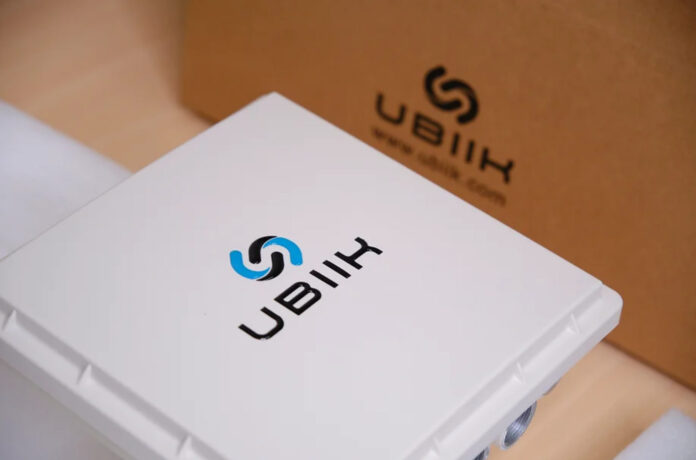Taiwanese industrial IoT provider Ubiik has released a network kit for running any LTE-based low-power wide-area (LPWA) IoT technology on private and hybrid cellular networks. These cellular IoT technologies include Cat-1, LTE-M, and NB-IoT, and the package covers usage in 410MHz and 450MHz bands 31, 72, 87, and 88, alongside standard LTE bands. It is aimed at industrial customers, most notably energy companies.
The new network kit, called goRAN Ignition Kit, includes its latest “full-software” Release 15 cellular IoT small cell, introduced at the start of the year under the Hermes brand, and billed as the first dual-mode RAN equipment for private NB-IoT and LTE-M at 410MHz and 450MHz. The kit includes connectivity out-of-the-box in all FDD and TDD bands in the 400MHz-2.6GHz range, including to work with Anterix’s B8, and Ligado’s 1.6GHz B24 spectrum.
The RAN component supports multi-carrier standalone NB-IoT, standalone LTE-M in 1.4 MHz and 3 MHz spectrum, as well as LTE Cat-1 and Cat-1bis at up to 5 MHz. It enables voice applications via VoLTE for both LTE-M and Cat 1. Its Cat-1 and Ethernet backhaul options mean it can operate as an eNodeB, connecting to an external Evolved Packet Core (EPC), or as an access point with built-in EPC and integrated HSS functions.
An external HSS can also be interfaced over 3GPP’s S6a standard interface. For private LTE networks deployed in the 450 MHz spectrum (3GPP bands 31, 72, 87, and 88), often preferred by utilities for private and hybrid AMI networks, the goRAN kit can be used to operate a standalone LTE-M network in 1.4MHz or 3MHz, besides, or an NB-IoT network with multi-carrier support (including a feature for Release 14 non-anchor carriers).
Ubiik, founded in 2016, started in the IoT space with Weightless, another LPWA technology, for advanced metering infrastructure (AMI) for utility providers. It has since grown its connectivity offerings to include LTE-based Cat-1, LTE-M, and NB-IoT. 3GPP Releases 14 and 15 make LTE-M and NB-IoT complementary with Weightless LPWA networks. It has worked with the 450 MHz Alliance on both of the Hermes small cell and the goRAN kit
The company is working with California-based cellular IoT cloud solutions provider Monogoto on the kits, with the latter supplying the core network component, plus a provisioning and management interface. The kit is available with end devices and modules, fitted with Monogoto’s pre-provisioned private LTE SIMs, as well – on request, said Ubiik. It said the new kit solution, offering “zero-configuration LTE-M/NB-IoT networks”, will “revolutionize cellular IoT.”
Fabien Petitgrand, chief technology officer at Ubiik, said: “We have been working for more than a year with the 450 MHz Alliance members to define and create a product that significantly moves the cellular IoT game on for the 450 MHz ecosystem. The cellular IoT Ignition Kit includes a flexible software defined radio architecture and a full core network in a box, with LTE-M and NB-IoT support, delivering breakthrough cellular IoT connectivity.”
Back in March, Ubiik confirmed the Hermes unit had been integrated with GCT Semiconductor’s GDM7243i LTE-M/NB-IoT chipset to operate at 900MHz, specifically with a view to target infrastructure and utility customers working with private networking firm Anterix, holder of the largest share of 900 MHz spectrum in the US (3MHz paired, at 896-901/935-940 MHz), with up to, offers a nationwide spectrum band in the US.
At MWC in Barcelona in February, it showed an “end-to-end” smart electricity metering solution on a private standalone LTE-M network, using its Hermes cell – with its RAN unit connecting to Monogoto’s core network via an IPsec VPN tunnel on the cloud-side, via a metering application stack for ANSI and IEC (DLMS/COSEM) meters, and in to a Monarch GM02S module from Sequans on the equipment side.
Ubiik used the Monarch module for its part in the “largest IoT project in Taiwan”, by the state-owned Taiwan Power Company, which will see six million IoT electricity meters deployed over the course of several years. Its work with the Taiwan Power Company was secured in three consecutive tenders, and is worth $45 million, it says. Ubiik has 650,000 connections under contract in Taiwan – with 300,000 “already deployed” on the Weightless protocol.
The company reckons the launch of a dual-mode LTE-M and NB-IoT private networking system, to attach to private LTE networks in industry, will serve an energy market that “require(s) a system with higher throughput or lower latency will now have a secure and high-performance 3GPP-compliant solution.” It claims “more than 99 percent of success rate” for meter data collection.
Ubiik – based in Taipei, with offices in Silicon Valley in the US and Osaka in Japan – raised $5 million in Series A funding in April last year, led by Taiwania Capital. The investment will fuel its “global expansion”, it said. It is already selling in Japan, the US, India, the Middle East, and sundry ASEAN countries. The company has around 70 staff in seven countries.
Petitgrand said: “Hermes… can operate as an all-in-one access point (embedded EPC/HSS/SGW/PGW), a small cell integrated with the customer’s EPC (over S1 interface) or HSS (over S6a), as well as a dedicated network with Ubiik-hosted or on-premises core network, with roaming capability over S8 interface. That would unlock innovative deployment schemes, for instance enabling MVNO customers to complement public networks’ coverage in their own guard bands. We have already integrated our solution with MVNO and chipset partners.”

